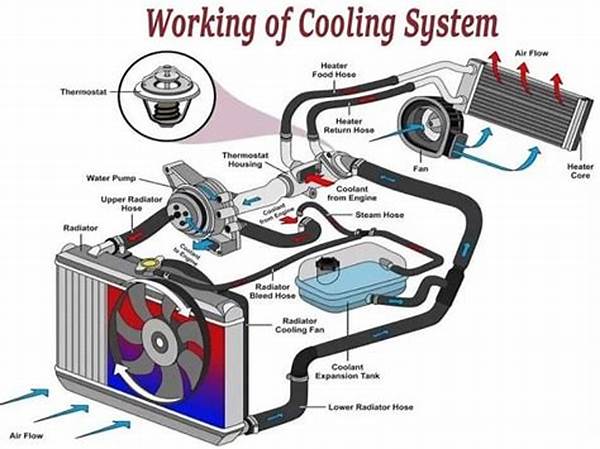
“symptoms Of Cooling System Failure”
In our quest for vehicle performance and longevity, the cooling system serves as an unsung hero, tirelessly working to prevent engine overheating. Yet, even the most reliable systems can falter, and when they do, recognizing the symptoms of cooling system failure becomes crucial. Ignoring these signs can lead to catastrophic engine damage and costly repairs. Therefore, understanding and identifying these symptoms is not just advisable—it’s necessary. Let’s delve deeper to appreciate the significance and implications of these symptoms on your vehicle’s health.
Read Now : **identifying Ignition Circuit Defects**
Identifying the Warning Signs
Recognizing the symptoms of cooling system failure early on can save you from the inconvenience of unexpected breakdowns and expensive repairs. Watching for these red flags is essential for ensuring your vehicle runs smoothly. If you notice that your engine is running hotter than usual, see steam or notice coolant leaking, or if your vehicle emits a strange, sweet smell, it may indicate cooling system problems. The presence of these symptoms should prompt immediate attention and swift action. By understanding these indicators, you can ensure the longevity and efficiency of your vehicle, preventing further complications and high repair bills.
Common Signs to Watch For
1. Overheating Engine: A consistently high engine temperature is a classic symptom of cooling system failure, indicating possible issues with coolant circulation.
2. Coolant Leaks: Puddles of coolant beneath your parked car should not be ignored as they suggest a breach in the system.
3. Low Coolant Levels: A frequently low coolant reservoir indicates a potential undetected leak or inefficiency in the cooling system.
4. Steam or Smoke: Visible steam from the engine area often signals overheating, a dire symptom of cooling system failure.
5. Unusual Sounds: Strange noises, such as hissing, may point towards compromised system components like a damaged radiator cap.
The Critical Role of Cooling Systems
A vehicle’s cooling system is not merely a comfort; it is a necessity. It prevents the engine from overheating, thus ensuring efficient performance. When the symptoms of cooling system failure appear, it reminds us of the system’s pivotal function. Ignoring these warning signs can lead to diminished fuel efficiency and severe engine damage. Picture being stranded on a sweltering day due to a neglected symptom. The importance of being proactive cannot be overstated. By understanding and respecting these symptoms, you can protect yourself from unwanted hassles and maintain your car’s performance.
Read Now : Vehicle Fuel Economy Optimization
Avoid the Costs of Neglect
When signs of deterioration in your car’s cooling system arise, they shouldn’t be brushed aside as trivial inconveniences. Neglecting the symptoms of cooling system failure often leads to dire consequences. We understand that maintenance can be cumbersome, yet contemplating the staggering repair bills for engine damage should motivate action. The cooling system ensures your vehicle runs at optimal temperature, preventing overheating that can lead to irreversible damage. Acting upon these symptoms not only prolongs your engine’s life but also safeguards your financial well-being.
Delving Deeper into System Check-ups
Regular inspections and maintenance are essential in preempting cooling system issues. Timely intervention when faced with symptoms of cooling system failure empowers vehicle owners to preserve engine longevity and efficiency. Consider it an investment in your vehicle’s future. Regularly checking fluid levels and inspecting hoses and belts can catch failures before they escalate into severe malfunctions. Proactively addressing these symptoms also signifies responsible car ownership.
Understanding Engine Indicators
A car engine’s temperature gauge can act as an early detection system for impending issues. Watching your dashboard for signs like the needle nearing the red zone can help you catch symptoms of cooling system failure before they cause significant damage. At the first indication of overheating, one should investigate the cause rather than dismiss it as a fleeting anomaly. Properly interpreting these indicators enables timely repairs, preventing costly setbacks.
Management through Awareness
Being aware of your vehicle’s normal operating conditions plays a critical role in identifying abnormal shifts indicating cooling system failure. This knowledge arms car owners with the foresight to detect issues early and act accordingly, ensuring the vehicle remains functional, efficient, and safe.
Prioritizing Vehicle Health
Ultimately, the safety and performance of your vehicle rest in the actions you take upon detecting symptoms of cooling system failure. As drivers, we are responsible for maintaining our vehicles to prevent emergencies. After all, vigilance and timely maintenance efforts not only preserve the vehicle’s reliability but also ensure road safety. Keeping these aspects in check reflects a commitment to responsible vehicle ownership and contributes to a stress-free driving experience.